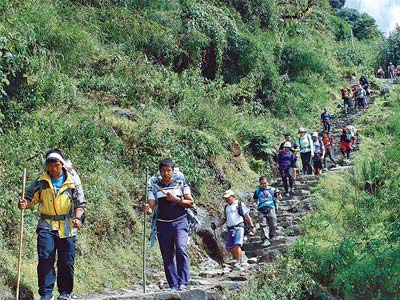

Tourism income hits Rs29.32b in five months

Nepal earned Rs29.32 billion in foreign exchange from the tourism industry in the first five months of this fiscal year 2017-18, according to the latest figures released by Nepal Rastra Bank (NRB).
The figure represents a steep 29.5 percent jump compared to the same period last year. The growth in receipts, based on swelling arrivals, signals that the country’s tourism revenues could surpass last year’s record. Nepal’s tourism earnings hit a record Rs58.52 billion in the last fiscal year. Annual foreign exchange earnings from tourism are calculated by adding the tourist service charge collected at the airport and monies earned by hotels and travel agencies, among other establishments. The calculation is also based on data received from money changers.
Arrivals to Nepal hit a new record in 2017 but remained short of the much ballyhooed target of 1 million individuals as national elections in November and December last year resulted in weaker-than-expected growth. The country received 940,218 tourists last year, up 24.86 percent from 2016. The figure includes overland travellers.
The sector is expected to expand further in the coming years considering the growing travel enthusiasm from India and China, the two most populous countries in the world.
Nepal’s hotel occupancy rate remained at an average 65 percent last year, according to Hotel Association Nepal (Han). “The year 2017 was a productive year for the industry,” said Binayak Shah, general secretary of Han. This is the first time in many years that the average occupancy rate has touched 65 percent.
Since 2011, the average occupancy rate of star hotels in Kathmandu has been hovering at 60 percent. The year 2015 was the worst year in Nepal’s tourism history due to the twin disasters of a devastating earthquake and punishing trade embargo. That year, the hotel occupancy rate had plunged to 25-30 percent. However, the industry rebounded in 2016.
“Despite the huge supply of new accommodation ranging from guest houses to home stays, the 65 percent average at star hotels can be termed good,” he said.
In the hospitality sector, an occupancy rate of above 40 percent is considered ‘survival’, and a rate higher than 50 percent is termed ‘fair’. An occupancy rate of above 60 percent is ‘good’, and 70 percent and higher is considered ‘excellent’.
Shah said that the tourism outlook for 2018 was also looking good. “We have been receiving good response at every international travel mart and fair,” he said, adding that advance airline bookings for the next tourist season beginning in March were encouraging. “This positive trend is also reflected in advance hotel bookings.”
However, the industry will always remain concerned due to the airport facilities which have turned into ‘roll and hold’ facilities due to increased passenger and aircraft traffic congestion, he added.
source: the kathmandu post,20 jan 2018








